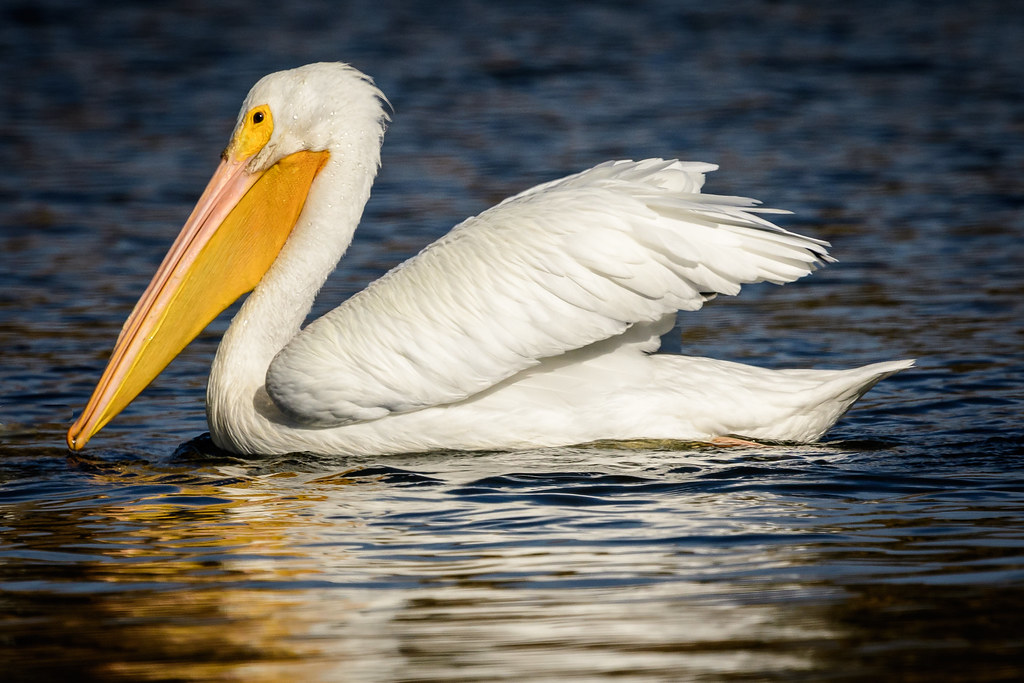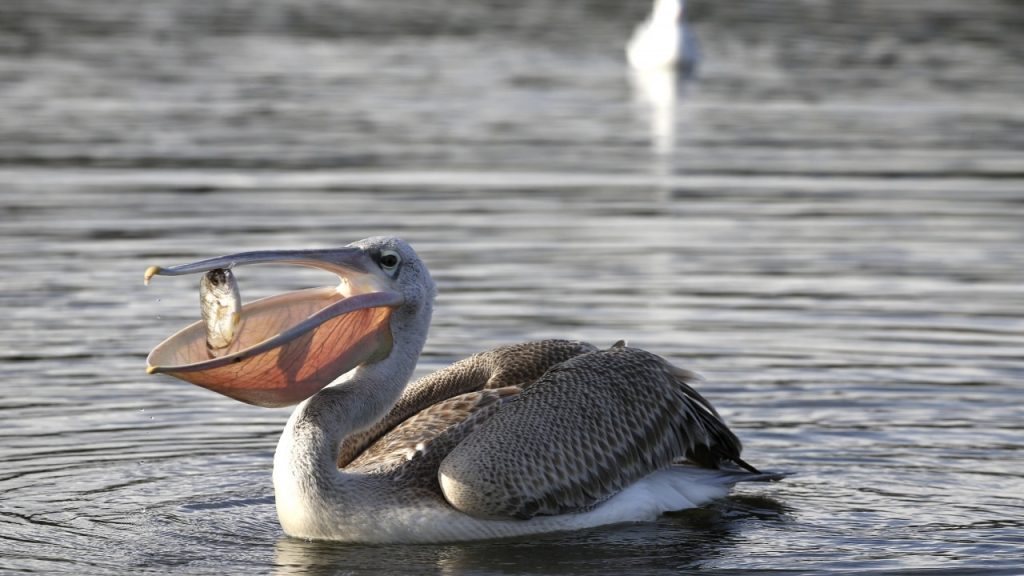In Idaho, you can encounter both species of Pelican that grace the North American landscape. These remarkable creatures are known as the American White Pelican and the Brown Pelican.
During the summer months, one can spot the American White Pelican in Idaho. However, the presence of the Brown Pelican in this region is rare, and sightings are infrequent.
Pelicans are among the largest birds on Earth and possess distinctive features such as their enormous bills, throat pouches, and sturdy feet. Despite their impressive size, they are surprisingly lightweight. Their skeleton and skin contain air pockets, aiding their buoyancy, while their elongated wings facilitate graceful soaring through the skies.
There are a total of eight pelican species worldwide, and North America is home to two of them: the American White Pelican and the Brown Pelican.
During the breeding season, pelicans undergo striking changes in their facial skin, throat, and bills, exhibiting vibrant colors and sometimes developing additional bill parts.
Pelicans tend to breed in colonies that can house up to an astonishing 50,000 birds. Depending on the species, these colonies may opt for ground-nesting or tree-nesting. After spending approximately 25 days in their nests, the young pelicans assemble in groups called “creches,” which can consist of up to 100 fledglings. Remarkably, the parents possess the ability to recognize their own offspring and provide exclusive nourishment to them.
Although pelicans feed on various animals, they are not classified as birds of prey, a distinction reserved for raptors. The primary diet of pelicans consists of fish, although they also consume crabs, frogs, snakes, mammals, birds, and insects.
To capture fish, pelicans employ their expandable throat pouches, which they use to ensnare their prey and subsequently drain the water before swallowing. Young pelicans even extract food directly from their parents’ pouches.
To aid bird enthusiasts in identifying the specific pelican species spotted in Idaho, this guide relies on avibase and data contributed by bird watchers on ebird, ensuring reliable and real-time information regarding the birds’ sighting patterns.
Idaho’s Pelicans: Two Species Unveiled!
American White Pelican

During the summer months, from April to September, the American White Pelican graces Idaho’s landscapes, while some individuals choose to remain year-round.
This majestic bird is predominantly observed in the western and southern regions of the state, as reported in approximately 6% of summer checklists provided by vigilant bird watchers.
The American White Pelican possesses a grand stature, gliding through the air with an impressive wingspan, which ranks as the second largest among all North American birds.
Adult non-breeding American White Pelicans exhibit an immaculate white plumage, except for their black flight feathers, which become apparent during flight or when their wings are fully extended. These pelicans showcase bluish-gray eyes and yellow facial skin encircling their eyes. Additionally, they boast pale orange bills, pouches, and feet. On the other hand, juvenile American White Pelicans display light gray feathers accompanied by darker brown napes.
During the breeding season, adult American White Pelicans undergo distinct transformations in their appearance. They develop a yellow plate on their upper bills, resembling a horn. Furthermore, while retaining their white bodies, their eyes, bills, legs, and feet assume a brighter orange hue.
Throughout the year, American White Pelicans experience molting changes, also known as “eclipse.” In the spring, a visible yellowish patch emerges on their breast and chest, while blackish feathers grace their heads during the summer months.
- Scientific name: Pelecanus erythrorhynchos
- Length: 60 – 63 inches (152 –160 cm)
- Weight: 246.4 ounces (6983 g)
- Wingspan: 96 – 110 inches (244 – 279 cm)
American White Pelicans breed in secluded inland lakes across North America before embarking on a winter sojourn along the southern Pacific Coast of the United States, the Gulf of Mexico, Mexico, and Central America. During migration, they may be sighted in various states across the western and central regions of the US.
The favored habitats of American White Pelicans encompass shallow freshwater lakes, wetlands, and the fringes of lakes and rivers. In winter, they can be found in coastal bays, inlets, and estuaries, where they engage in foraging activities in shallow water and seek respite on sandbars.
Their diet predominantly consists of fish, and they employ a surface-swimming technique coupled with their immense bills to secure their prey. American White Pelicans often partake in group foraging, employing strategic and coordinated efforts to corral fish toward the shore, facilitating efficient consumption.
They also exhibit opportunistic feeding behavior, venturing far and wide in search of abundant feeding grounds. On occasion, they consume crayfish, amphibians, and salamanders. Additionally, these pelicans are known to pilfer fish from other birds while they rest atop the water’s surface.
When it comes to vocalizations, American White Pelicans are typically silent, emitting only occasional grunts. However, the young ones can become quite noisy within large colonies as they vocalize their pleas for sustenance.
Regarding their nesting habits, American White Pelicans construct simple and shallow depressions on the ground. They add twigs, sticks, reeds, and other materials atop the soil to provide protective cover for their eggs.
The female pelican subsequently lays one to two eggs, which are incubated jointly by both parents for a period of up to thirty-six days. Unfortunately, due to siblicide (when one sibling eliminates the other), only one chick per nest typically survives.
Fascinating Fact: The American White Pelican’s elongated bill possesses an astonishing capacity to hold three gallons of water. To consume the fish they catch, these pelicans tilt their bills downward, allowing the water to drain, thus enabling the swallowing of the remaining fish residing within their throat sacs.
Brown Pelican

The Brown Pelican is a rare and occasionally accidental visitor to Idaho, with its last reported sightings dating back to 2019 around Mann Lake and Hells Gate State Park.
Non-breeding adult Brown Pelicans exhibit white heads and necks with pale yellow foreheads. Their elongated bills display a combination of yellow and orange hues. Their bodies present a grayish-brown coloration, complemented by short black legs and webbed feet. Juveniles, on the other hand, boast brown heads, necks, backs, and wings, along with bluish-gray bills. Their underparts exhibit a light brown tone.
This pelican species consists of five subspecies, two of which breed within the United States. The Pacific Coast variant is referred to as P.o.californicus, while the Atlantic Coast variant is known as P.o.carolinensis.
The distinctions between Pacific and Atlantic Brown Pelicans become more apparent during the breeding season. Both species display white heads with prominently yellow foreheads. However, their napes transition from white to dark brown. Atlantic Brown Pelicans possess olive-brown throat pouches, while their Pacific counterparts exhibit red skin within their throat pouches.
- Scientific name: Pelecanus occidentalis
- Length: 48 – 50 inches (122 – 127 cm)
- Weight: 131.2 ounces (3718 g)
- Wingspan: 78 – 84 inches (198 – 213 cm)
Brown Pelicans either breed and migrate or maintain year-round residency along the Pacific and Atlantic Coasts of North America, extending down to northern South America.
These pelicans favor habitats characterized by shallow water environments. They establish their year-round presence in estuaries and coastal marine habitats. When in a state of rest, you may observe them on mangrove islets, sandbars, breakwaters, and offshore rocks.
An exceptional foraging ability distinguishes the Brown Pelican. They possess the capacity to dive into the depths of the ocean to capture prey within their throat pouches. Upon resurfacing, the water drains from their pouches, enabling them to swiftly consume their catch.
Their primary diet consists of fish, particularly sardines and herring. When not engaged in diving, Brown Pelicans adeptly swim and seize their prey using their bills. They may also consume crustaceans such as prawns, as well as amphibians, eggs, and other young birds.
As for vocalizations, adult Brown Pelicans tend to be relatively silent, occasionally emitting grunts. Juveniles, however, vocalize more frequently as they entreat for nourishment.
Nesting habits among Brown Pelicans lean towards ground-based construction rather than utilizing trees. They commonly establish nests concealed and protected on islands, amidst mangroves, or along cliffs. The female pelican constructs the nest using reeds, leaves, pebbles, and sticks, fortified with soil. Subsequently, she lays two to four eggs, which are diligently incubated by both parents for approximately a month.
Fascinating Fact: Brown Pelicans employ their webbed feet to cover their eggs during the incubation period. Unfortunately, this practice posed a threat to the species in the past, as the pesticide DDT led to the thinning of eggshells, rendering them susceptible to breakage under the weight of their parents’ feet. Thanks to extensive conservation efforts, Brown Pelican populations have experienced recovery and restoration.
